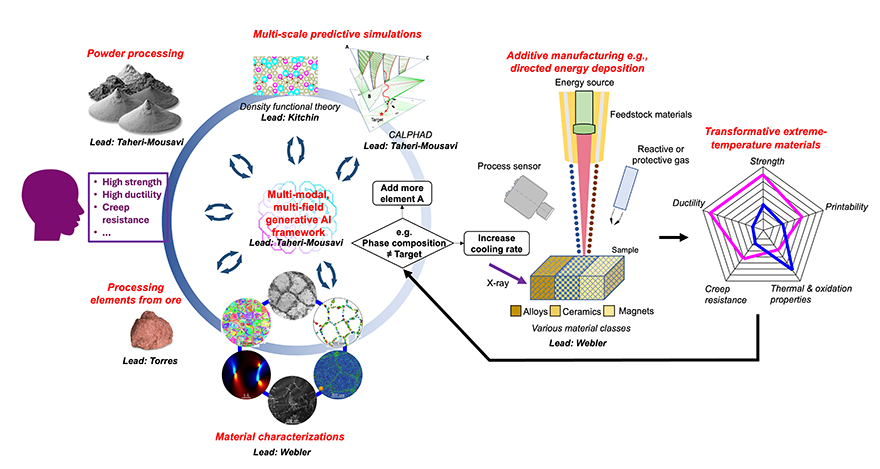Interdisciplinary team partners to develop advanced alloys
Faculty from the materials science and engineering and chemical engineering departments will collaborate on projects supported by the Naval Nuclear Laboratory to create advanced additively manufactured structural alloys that can sustain extreme environments.
A Carnegie Mellon University team has been tapped by the Naval Nuclear Laboratory to lead two interconnected projects that aim to develop advanced additively manufactured structural alloys that can sustain extreme environments. The projects will be supported through funding of $1 million per year for two years. The team is specifically interested in using rare earth elements (REEs) in the composition to enhance the alloys’ properties.
Led by principal investigator Mohadeseh Taheri-Mousavi, assistant professor of materials science and engineering, the projects bring together the expertise of both materials scientists and chemical engineers. The team intends to design the full cycle of developing alloys from the extraction of elements from ores, to refining their properties. Because REEs are currently mostly imported from other countries, this project has potential to develop a more sustainable pipeline for their exploitation.
“These elements have high potential that has yet to be fully explored,” says Taheri-Mousavi. “Through this work, we will be able to design additively manufactured alloys, specifically those containing the rare earth elements while we consider processing and manufacturing conditions in the design objectives.”
These elements have high potential that has yet to be fully explored.
Mohadeseh Taheri-Mousavi, assistant professor, materials science and engineering
Ana I. Torres, assistant professor of chemical engineering, will design innovative and environmentally friendly processes for the recovery of REEs from different feed sources and their purification into commercial grade for use in alloys.
“The U.S. possesses relatively large amounts of REE reserves but faces significant challenges in meeting its internal demand as it lacks processing capacity,” notes Torres. “Our process design and enviro-technoeconomic analysis efforts are key to establish how much it really costs to internally process REEs with modern environmental standards.”
Additional collaboration from the Department of Chemical Engineering will stem from data that will be curated by John Kitchin, professor of chemical engineering, who will create a database for different phase structures of these alloys.
Through this data, Taheri-Mousavi and her research group will develop and perform integrated computational materials engineering (ICME) simulations to discover the non-linear roles of the elements on various properties. Because the design space is high dimensional and complex, the simulations will be combined with generative AI to incorporate different modalities of data, explore the design space more efficiently, and reduce the time for the design.

This interdisciplinary project will bring together processing, simulation, and characterization to develop transformative materials that can sustain extreme-temperatures.
From this point Bryan Webler, professor of materials science and engineering, will create the alloys in the additive manufacturing laboratory at Mill 19 using both laser powder bed fusion and powder-feed direct energy deposition methods.
“The first step is determining if we can print these materials without major defects,” says Webler. “We start by exploring the effects of processing variables on the print outcomes. Once we determine we can print something without defects, then we characterize the microstructure and properties in detail.”
The results of Webler’s work will provide feedback for validation and next design iterations from Taheri-Mousavi, with the intent of improving predictions.
Seven doctoral students and postdoctoral scholars across the materials science and chemical engineering departments will have the opportunity to contribute to this work.
In addition to funding from the Naval Nuclear Laboratory, support from the Scott Institute for Energy Innovation and the Army Research Laboratory has enabled some of the preliminary results for this project.
